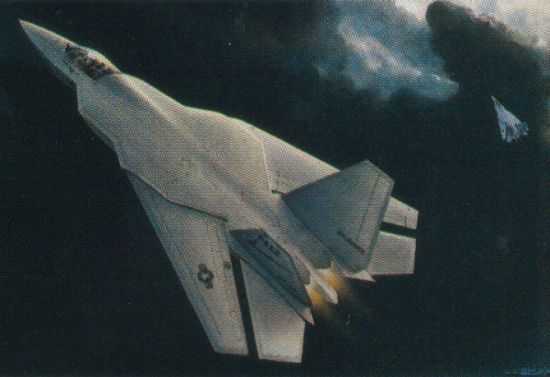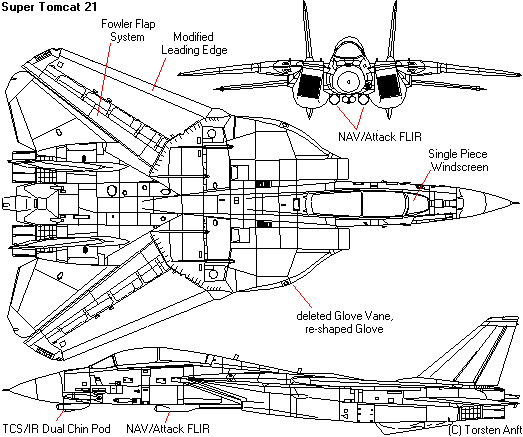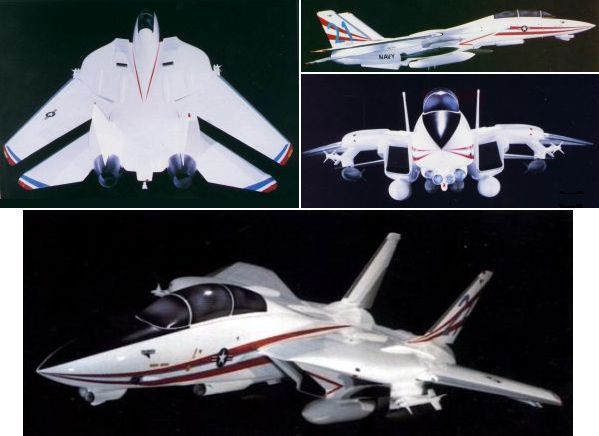|
||||||||||
|
|
||||||||||
|
||||||||||
|
|
||||||||||
During the late 1980s, the Navy also briefly considered purchasing up to 550 examples of a navalized variant of the Air Force's Advanced Technology Fighter (ATF) as a potential F-14 replacement. However, the Navy lost interest before the EMD contract was awarded to Lockheed's F-22 Raptor, although a Lockheed proposal for such a design is illustrated below.

As you indicated, the primary means of distinguishing the navalized model from the basic F-22A was the addition of variable-geometry "swing" wings similar to those used on the F-14. Though the Navy went so far as to formulate a Naval Advanced Technology Fighter (NATF) requirement, the plan was soon abandoned when the service decided to instead focus its resources on the A-12 Avenger stealth attack plane that was planned to replace the A-6 Intruder.
However, the A-12 was eventually cancelled due to cost overruns and mismanagement, and Lockheed proposed another derivative of the F-22 to meet the Navy's A/F-X attack fighter requirement. This proposal never attracted much attention, though, since the Navy had decided to develop the F-18E/F as its primary attack fighter. The service's greatest fear was that involvement in the F-22 program would divert much needed funding, and both projects might end up being cancelled as a result.
A number of improved F-14 models were also proposed by Grumman as potential replacements for the original aircraft. One of the earliest of these was the Quickstrike concept with a mission similar to that of the Air Force's F-15E Strike Eagle. Quickstrike was proposed as a low-cost replacement to the cancelled A-12, the goal being to develop a new model based on the F-14D but with a significant ground attack capability. The aircraft was to be fitted with a Forward-Looking Infrared (FLIR) pod, synthetic aperture and Doppler Beam Sharpening ground mapping modes for its APG-71 radar, upgraded navigation and targeting pods, and moving-map displays. Weapons carriage was to be provided by four hardpoints under the central fuselage, each carrying five munitions substations, plus two wing glove pylons carrying two munitions substations each. Potential weapons to be employed were laser-guided bombs, the SLAM long-range land-attack missile, the Maverick air-to-surface missile, the HARM anti-radiation missile, and the Harpoon anti-ship missile. Quickstrike production was to consist of remanufactured F-14D models rather than new-build aircraft.

A similar concept was the Super Tomcat 21 (ST21), which built on the Quickstrike proposal but added additional improvements. Super Tomcat 21 offered the FLIR, radar modes, and weapons layout of Quickstrike but went further by adding significant changes to the airframe. Among the changes was a redesign of the wing gloves to improve maneuverability and supersonic aerodynamics as well as provide room for enough additional fuel that would nearly double the aircraft's range. Other improvements included more powerful engines, improved high-lift devices on the wings for lower carrier landing speeds, and a single-piece cockpit windscreen to improve visibility.
A related proposal was the Attack Super Tomcat 21 (AST21). The AST21 was generally similar to the Super Tomcat 21, but with even more additional fuel carried in a thicker wing and the ability to carry larger external stores, including nuclear weapons. Other improvements were to include the ability to carry bombs beneath the engine nacelles, addition of a forward air control mode to the radar, greater armor protection for the cockpit, and the fitting of an Integrated Defensive Avionics Package (IDAP). As with the Quickstrike proposal, the ST21 and AST21 were both to have been rebuilt from the existing fleet of F-14D aircraft.

An even less expensive offering from Grumman was the F/A-14D, a proposal to upgrade existing F-14A, F-14B, and F-14D airframes to provide an improved ground attack capability. Improvements were to include bringing all models up to the F-14D standard and also fitting a FLIR, a new databus, a towed decoy, and a full night vision cockpit. The APG-71 radar would also be upgraded with Doppler beam sharpening, synthetic aperture, sea surface search, moving target indication, and terrain-following modes.
The most sophisticated of Grumman's proposals was the ASF-14, intended as a cheaper alternative to the Naval ATF. Unlike the previous models, which were all upgrades to existing airframes, the ASF-14 was to be a radically redesigned new-build aircraft. The ASF-14 would have used the F-14D as a starting point and incorporate many of the multi-role fighter and ground attack features proposed for the Quickstrike and Super Tomcat 21. However, the ASF-14 went much further by integrating methods to significantly lower the aircraft's radar cross-section. In addition, the new design was to feature more powerful engines, to make supercruising possible, plus thrust vectoring nozzles for improved maneuverability. These radical upgrades would have made the ASF-14 the most expensive of Grumman's proposals by far, but offer a significant advancement over the existing F-14 fleet.
But as was indicated earlier, none of these proposals were accepted by the Navy, which has instead focused on the
F-18E/F Super Hornet to fulfill the air combat role of the F-14 and attack capabilities of the A-6.
- answer by Jeff Scott, 13 July 2003
Related Topics:
I would like to know about the F-14A Tomcat used by Iran.
What can you tell me about the history of the F-22?
Read More Articles:


|
Aircraft | Design | Ask Us | Shop | Search |

|
|
| About Us | Contact Us | Copyright © 1997- | |||
|
|
|||